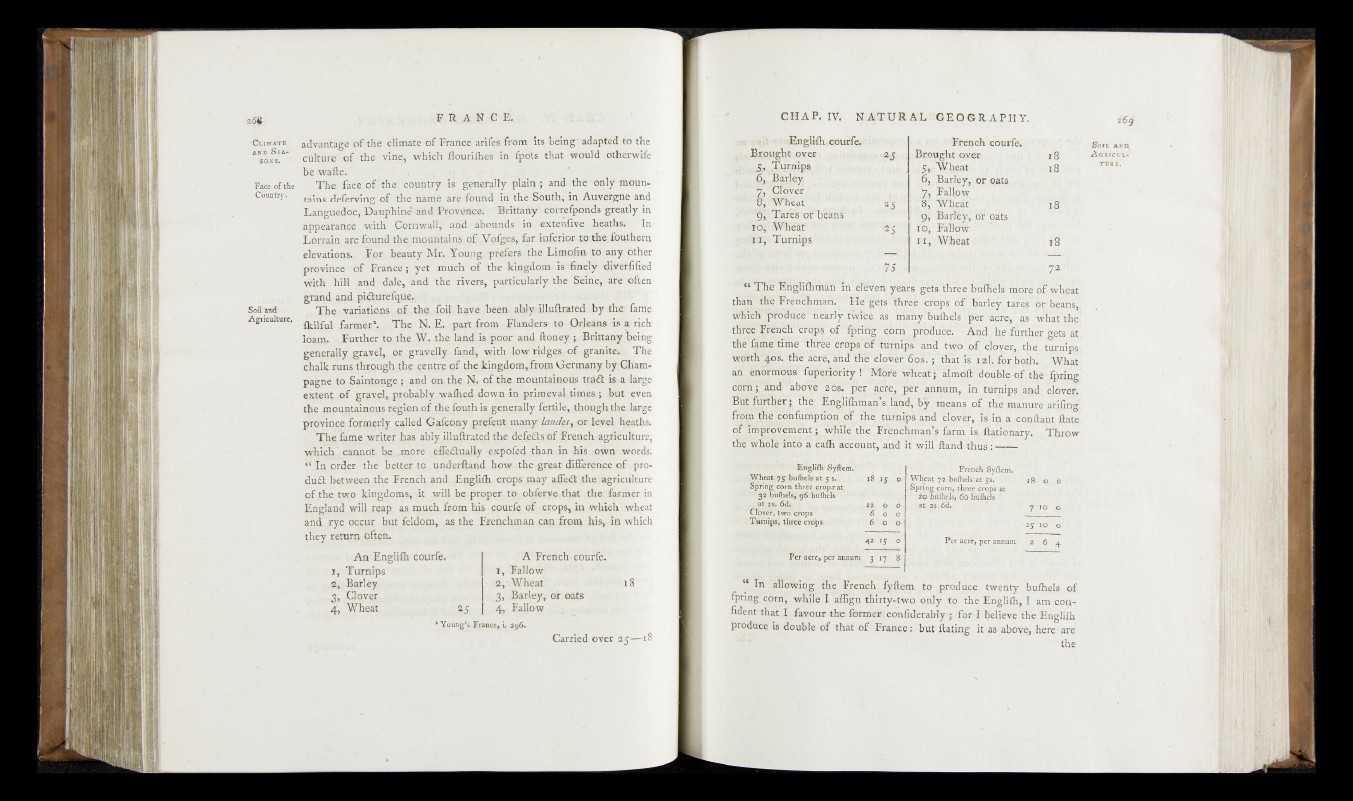
26$ F R A N G E.
■ CllMlTB
AKiD;SfJ^Ï
''»SÔïrS}
F a c e o f the
Country.:
Soil and
Agriculture.
advantage of thé. climate o f France arifes-from its being'adapted to ;the
culture o f the vine', wh ich flourifheâr'in fpots that would''feherwife
be wafte. '
The» face o f 'th e ' cöunt-ry is generally plîtirr; and the only m o u n tains
deferving o f th e name are. found^ irf'the ’South, in Auvergne and
Languedoc,-» Dauphiné and •Provence. Brittany'- éorrefponds greatly in
appearance with-, â è jk wall, an d'abounds in -"extenfive heaths, p in
Dôrrfl£f3»-,are found the» mountains, of^Yofg^, far. inferior
elevations..- For beauty-Mr, ^cuing' •'p^&rs the to anyislher
province of France ; yet -much of the kingdom, is 'finely djye-r-fified
tvith hill and dale, and the rivers,- particularly the Seine, are -often
grand and phftusefcju«.,. .
.The variations o f the foil haver been ably illuftrated /bynthes fame
%;ifnl former V ,/T h e ^ * 1 » pa rtfro rn ■ Flan^irsi.t#
loam. A Further tq the W* the lahd is'pqor iand % n p ÿ * fB ïitta h j b rin g
generally gravel, or gr^vçlly %Q§, with ridgqs-. of granite^, f he
chalk runs through the.centre q f theJ;ingdOm*|f§fn Q-ennany;bÿ>6<ham-
pagne to Saintonge ; and cm the qf tb i uioqotaintmp tfoö: Jsppoege
extent o f gravel, probably wafhed '«yen.
the monat.dno.us region, of th e f e i^ b ^ e n s r a j ly fe^le,.$bOft&h>therlairge
provmce fofmerly called .Gafeûny prelent inany'(<2»^,;'ôr lèyel htaths.
T h e fame winter bas ably illuftrated f^e 4^^p:s^f(ErtMh(5agittdul6une,
which ."eaanfitj be more 1 e f e ^ n a h y r^spofed -djfoï*in ®isi.own|^bitds.
“ In order - th e better to underftand . how -t-he-great diüerènee ^ a p r o -
dii£t between the French and, Engiifh cfops/may &fe£t.the ragrjculKre
o f the two kingdoms, U -will be proper to. ohferyo th a t the-.farmer in
England, .whl-bsap.. as mneh/ftom crogs^in wbieh7;wl^àl
and rye occur but feldom,. ae the Frenchman can; from his, i f which
they return often.
An Englifo éowrfè. - [' A F r e n cK f lb i^ ^ f
1, Turnips ~
2, Barley
J i , Fallow
j. 2, Wheat
3, C I q v ç ç . . 1 3, Barley,;'or oats
4 , Wheat à «5. 1 4 > -
' * Young’s. France, i. 296.
CH A P . IV; N A I|H |R A E 'G E O G R A PH Y.
lEagldfh.courfe.'
j g j h ■
(>,.p a rley - ”>
7 ,1 C rôvefLf
.,3 3 5 :
Ç. ^Wlfeat f
^ ’fT a r e s owbeans
S
Èÿô',ili¥ h 'é à t, W ; -25
ia iipTurnips ' | '
j H
French courfe.
Brought .over 18
1 o5n ,WheAt I 18
: 6y Bapley,, or oats .
Fallow
vS, Wheâp iS
dgj BarPëy,' or oats
. iô, ! Fallow ?
t i , W N a t '• ' i8
“ FTlfe Englifhmah in ‘ eleven^ years' geW ^ ^ 'J ju f h e l s more o f wheat
than1 fee F r é f t^ f f ia h ^ l i e gejs‘^fireè pfeps o f f e a r l e y A ^ ^ p r beans,"
whicHflpÿdluoe” lifearfy fvfîee, a t p e r 'acre. |1 § whaf the,
tfeee E f e n ih ^m d s ' o f ^ f p r i ^ 1 com ,p ro f fu c S 'A n d t he further gets ah
theifamei tittiç fîffge'^r&gg- o F # M b ^ à h d d g o
worth W i . (the°acre, and fePSover\6o|3. j'-that js L2J, for b o fe W hat-
ati ehotnnro’| ‘sOTm ^ r io n lyY More wfieat* £1 a lm p lf‘doubleiqf fep £pr,iqg
COTn,;; And- ||f|a n in um ,
B^ H rthér ’ ^ 7 Englifjiman sdlpttd, by means pif th e manure ^riling*
from tlf e c onfumption of fe 4v turnips (’and clqvey, js-.ip. a .cbndan.t'fhte
of P a n r ^ m e n t ; ,wïïne',t|î e 'Frenchman's f a rm H f t^ io n a r y ./^ h r q w
the whole in to 'a caln aefcount, a n d lt .'w^llf ^ f e d thus!:’ ------■
v ' S f fg l® Sÿf^emv
.Wheat 75;hufh,els^t;5,s,ift ,'j8 0
" ffpich âÿftèm./'
Wheat 72.1niihels at '5-S. -. j 8 0. 0
CTopy at
52 bulhels^ 9^'ljtiflieJfr
I j I \2 €* •b)
tb>SR
J 20 hraffttff,. hufliéts '
'yhiïb'. ,.0..
Cïovèr,two'€rops' ^ mm$ P |
-Turnips^ three crops: hi6< ':b- f f f g j g M r a d
4?' H Pér acrej pér ^fym' ■. 2 ' 6-' .
Per acre,, per annum1 1 ' 8
“ In dIowing£‘ fe^ Fjreirc^ fy^em ?,tq .jprodupe. twfntry bufhels- of
fpring-.-corn, while I adign th irty -tw d 'p n l^ to mfe Engljffi,-r am confident,
that I favour t-hle: forme*; confiderab’lyfj.-.for I believe the E^glife
produce is double o f that of France: ■ but'ftating it as above,.here are